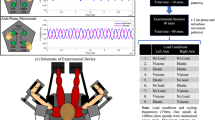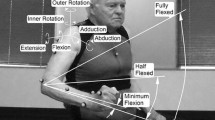Abstract
Although rhythmic coordination has been extensively studied in the literature, questions remain about the correspondence of constraints that have been identified in the related contexts of inter-limb and intra-limb coordination. Here we used a 2-DOF robot arm which allows flexible manipulation of forces to investigate the effect on coordination stability of intra-limb coordination of: (i) the synchrony of force requirements and (ii) the involvement of bi-functional muscles. Ten subjects produced simultaneous rhythmic flexion–extension (FE) and supination-pronation (SP) elbow movements in two coordination patterns: (1) flexion synchronized with supination/extension with pronation (in-phase pattern) and (2) flexion synchronized with pronation/extension with supination (anti-phase pattern). The movements were produced with five different settings of the robot arm: a neutral setting that imposed balanced force requirements, and four other settings that increased the force requirements for one direction in both DOF. When combined with specific coordination patterns, these settings created conditions in which either synchronous or alternate patterns of forcing were necessary to perform the task. Results showed that synchronous tasks were more stable than asynchronous tasks (P < 0.05). Within the synchronous tasks, some robot settings were designed to either increase or decrease the use of bi-functional muscles. Although there was no difference for the bi-functional muscle biceps brachii, the coordination was more stable for the condition in which the greatest force requirements corresponded to the mechanical action of the bi-functional pronator teres (P < 0.05). In conclusion, force synchrony increases the stability of rhythmic intra-limb coordination, but further research is needed to clarify the role of bi-functional muscles in this effect.




Similar content being viewed by others
References
Baldissera F, Cavallari P, Civaschi P (1982) Preferential coupling between voluntary movements of ipsilateral limbs. Neurosci Lett 34:95–100
Batschelet E (1981) Circular statistics in biology. Academic Press, London
Buchanan JJ (2004) Learning a single limb multijoint coordination pattern: the impact of a mechanical constraint on the coordination dynamics of learning and transfer. Exp Brain Res 156:39–54
Buchanan JJ, Kelso JAS (1993) Posturally induced transition in rhythmic multijoint limb movements. Exp Brain Res 94:131–142
Buchanan JJ, Zihlman K, Ryu YU, Wright D (2007) Learning and transfer of a relative phase pattern and a joint amplitude ratio in a rhythmic multijoint arm movement. J Mot Behav 39(1):49–67
Carroll TJ, Barry B, Riek S, Carson RG (2001) Resistance training enhances the stability of sensorimotor coordination. Proc Biol Sci 268:221–227
Carson RG, Oytam Y, Riek S (2009) Artificial Gravity Reveals that economy of action determines the stability of sensorimotor coordination. PLoS ONE 4(4):e5248. doi:10.1371/journal.pone.0005248
Cohen L (1971) Synchronous bimanual movements performed by homologous and non-homologous muscles. Percept Mot Skills 32:639–644
de Rugy A, Riek S, Carson RG (2006a) Neuromuscular-skeletal origins of predominant patterns of coordination in rhythmic two-joint arm movement. J Mot Behav 38:7–14
de Rugy A, Riek S, Carson RG (2006b) Influence of predominant patterns of coordination on the exploitation of interaction torques in a two-joint rhythmic arm movement. Exp Brain Res 175:439–452
de Rugy A, Riek S, Oytam Y, Carroll TJ, Davoodi R, Carson RG (2008) Neuromuscular and biomechanical factors codetermine the solution to motor redundancy in rhythmic multijoint arm coordination. Exp Brain Res 189:421–434
Dounskaia NV, Swinnen SP, Walter CB, Spaepen AJ, Verschueren SMP (1998) Hierarchical control of different elbow-wrist coordination patterns. Exp Brain Res 121:239–254
Dounskaia N, Ketcham CJ, Stelmach GE (2002) Commonalities and differences in control of various drawing movements. Exp Brain Res 146:11–25
Hoy MG, Zernicke RF (1986) The role of intersegmental dynamics during rapid limb oscillations. J Biomech 19(10):867–877
Jamison JC, Caldwell GE (1993) Muscle synergies and isometric torque production: influence of supination and pronation level on elbow flexion. J Neurophysiol 70:947–960
Kelso JAS, Buchanan JJ, Wallace SA (1991) Order parameters for the neural organization of single, multijoint limb movement patterns. Exp Brain Res 85:432–444
Riek S, Carson RG, Byblow WD (1992) Spatial and muscular dependencies in bimanual coordination. J Hum Mov Stud 23:251–265
Russell DM, Sternad D (2001) Sinusoidal visuomotor tracking: intermittent servo-control or coupled oscillations? J Mot Behav 33:329–349
Salesse R, Oullier O, Temprado JJ (2005) Plane of motion mediates the coalition of constraints in rhythmic bimanual coordination. J Mot Behav 37:454–464
Shemmell J, Forner M, Tresilian JR, Riek S, Barry BK, Carson RG (2005) Neuromuscular adaptation during skill acquisition on a two degree-of-freedom target-acquisition task: isometric torque production. J Neurophysiol 94:3046–3057
Temprado JJ, Swinnen SP, Carson RG, Tourment A, Laurent M (2003) Interaction of directional, neuromuscular and egocentric constraints on the stability of preferred bimanual coordination patterns. Hum Mov Sci 22:339–363
Acknowledgments
This work was supported by the Australian Research Council (ARC).
Author information
Authors and Affiliations
Corresponding author
Rights and permissions
About this article
Cite this article
Stosic, J., Carroll, T.J. & de Rugy, A. Force synchrony enhances the stability of rhythmic multi-joint arm coordination. Exp Brain Res 213, 117–124 (2011). https://doi.org/10.1007/s00221-011-2781-1
Received:
Accepted:
Published:
Issue Date:
DOI: https://doi.org/10.1007/s00221-011-2781-1




